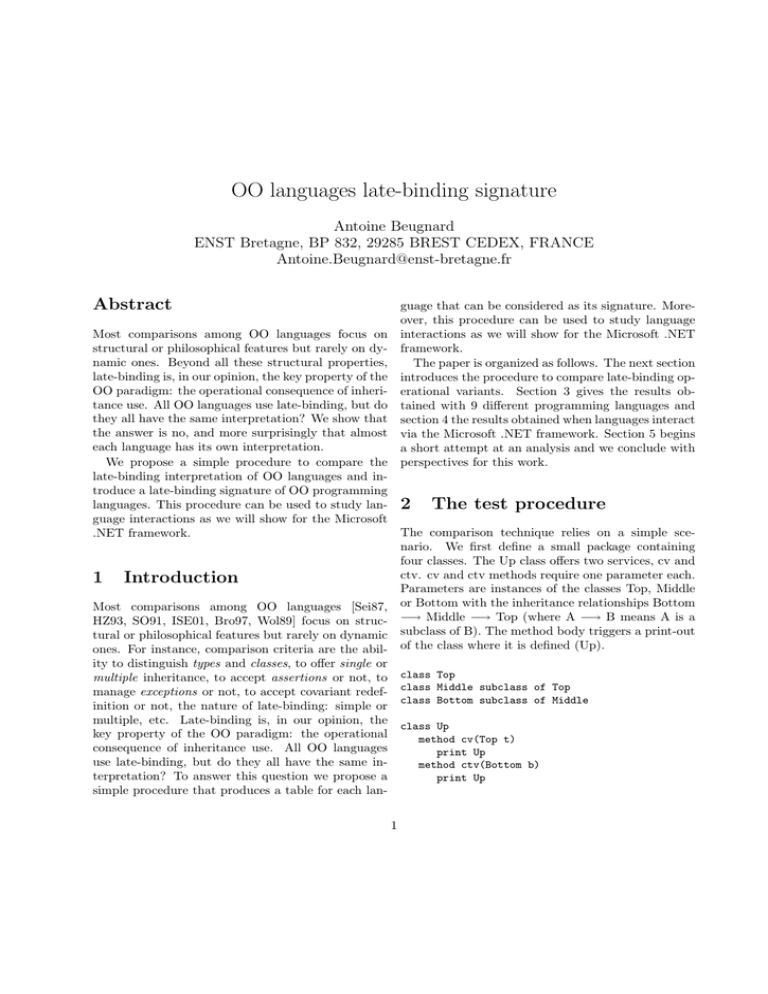OO languages late-binding signature
advertisement

OO languages late-binding signature Antoine Beugnard ENST Bretagne, BP 832, 29285 BREST CEDEX, FRANCE Antoine.Beugnard@enst-bretagne.fr Abstract guage that can be considered as its signature. Moreover, this procedure can be used to study language Most comparisons among OO languages focus on interactions as we will show for the Microsoft .NET structural or philosophical features but rarely on dy- framework. namic ones. Beyond all these structural properties, The paper is organized as follows. The next section late-binding is, in our opinion, the key property of the introduces the procedure to compare late-binding opOO paradigm: the operational consequence of inheri- erational variants. Section 3 gives the results obtance use. All OO languages use late-binding, but do tained with 9 different programming languages and they all have the same interpretation? We show that section 4 the results obtained when languages interact the answer is no, and more surprisingly that almost via the Microsoft .NET framework. Section 5 begins each language has its own interpretation. a short attempt at an analysis and we conclude with We propose a simple procedure to compare the perspectives for this work. late-binding interpretation of OO languages and introduce a late-binding signature of OO programming languages. This procedure can be used to study lan- 2 The test procedure guage interactions as we will show for the Microsoft The comparison technique relies on a simple sce.NET framework. nario. We first define a small package containing four classes. The Up class offers two services, cv and ctv. cv and ctv methods require one parameter each. 1 Introduction Parameters are instances of the classes Top, Middle Most comparisons among OO languages [Sei87, or Bottom with the inheritance relationships Bottom HZ93, SO91, ISE01, Bro97, Wol89] focus on struc- −→ Middle −→ Top (where A −→ B means A is a tural or philosophical features but rarely on dynamic subclass of B). The method body triggers a print-out ones. For instance, comparison criteria are the abil- of the class where it is defined (Up). ity to distinguish types and classes, to offer single or multiple inheritance, to accept assertions or not, to manage exceptions or not, to accept covariant redefinition or not, the nature of late-binding: simple or multiple, etc. Late-binding is, in our opinion, the key property of the OO paradigm: the operational consequence of inheritance use. All OO languages use late-binding, but do they all have the same interpretation? To answer this question we propose a simple procedure that produces a table for each lan- class Top class Middle subclass of Top class Bottom subclass of Middle class Up method cv(Top t) print Up method ctv(Bottom b) print Up 1 procedure main – receiving objects Up u, ud; Down d; – possible parameters Top t = new Top(); Middle m = new Middle(); Bottom b = new Bottom(); – First test – Second test – Third test u := new Up(); d := new Down(); ud := new Down(); u.cv(t); u.cv(m); u.cv(b); u.ctv(t); u.ctv(m); u.ctv(b); d.cv(t); d.cv(m); d.cv(b); d.ctv(t); d.ctv(m); d.ctv(b); ud.cv(t); ud.cv(m); ud.cv(b); ud.ctv(t); ud.ctv(m); ud.ctv(b); calls cv(t) cv(m) cv(b) ctv(t) ctv(m) ctv(b) u Up Up Up Error Error Up d Up Down Down Error Down Down ud Up Down Down Error Error Down Table 2: An example of results controversy opposed computer scientists in order to decide which redefinition is the correct one. Theorizers were in favor of contravariance since it is semantically sound and simple. Practitioners observed that concrete programs often use covariance. In [Cas95] Table 1: The three tests G. Castagna unifies the two points of view showing that they can be used together for different purposes; Then we specialize class Up with a Down subclass the contravariance rule captures code substitutivity that redefines the two services as follows: (always replace) while the covariant rule characterizes code specialization (replace in some special cases). class Down subclass of Up Another common OO semantics used is invariance. -- a covariant redefinition of cv We could have added an inv(Middle m) method in Up method cv(Middle m) and Down with exactly the same declaration in both print Down classes. For the sake of brevity, we ignore this case -- a contravariant redefinition of ctv method ctv(Middle m) in the following tests since all languages deal with it print Down in the same way1 . When neither covariance nor contravariance are accepted by a language, one uses method overloading, In order to observe the behavior of late-binding, a i.e. the capacity to use the same method name with client calls all (18) possible parameter combinations different parameter types (signature). This approach as shown in table 1. Note that the results of columns is strongly criticized by B.Meyer [Mey97] who argues 2 and 3 are identical for languages that do not require that if programmers want to change the signature of object declaration. a service, it is much better to change the name of the In order to avoid any attempt at class or method service than to use the same name with a different name interpretation, and to concentrate on runs only, type or number of arguments. we have chosen names with only mnemonic connotaThe result of a test consists of a 3x6 slot table tions. with one column per receiver object (u, d, ud Down The scenario proposes both covariant and con- declared as Up). The content of the slot names the travariant method redefinitions. Covariant redefi- class where the code has actually been found. When nition means that the argument type varies in the a compilation error occurs the result is ”Error” and same way as the inheritance hierarchy, i.e. Down −→ when a runtime error occurs the result is ”Run. ErUp and Middle −→ Top. Contravariant redefinition ror”. Table 2 shows an example of results. means that the argument varies in the opposite way, 1 but for compilation error detection. i.e. Down −→ Up and Middle ←− Bottom. A long 2 This kind of table shows the expected results for a language. It also gives some information about the compiler’s features. For instance, slot (5,3)2 triggers an error in table 2. The reason is that when calling ctv(m) we imagine the programmer expects to find only services declared in Up class, even if s/he knows that a more specialized object can actually be used. If an error is not detected, this means that the Up class and its clients should be recompiled each time a subclass redefines some of its methods. That means it is impossible to build an incremental safe compiler. 3 calls cv(t) cv(m) cv(b) ctv(t) ctv(m) ctv(b) d Error Down Down Error Down Down ud Up Up Up Error Error Up Table 3: C++ results appels cv(t) cv(m) cv(b) ctv(t) ctv(m) ctv(b) Single language signatures Tables 3 to 10 show results found with 9 popular OO languages where all parts of the scenario are programmed in the same language. We used the following languages: C++ [Str97], C# [Lib01], CLOS [Ste90], Dylan [Cra96], Eiffel [Mey92], Java [AGH00], OCaml [RV98], Smalltalk [GR83] and VisualBasic [Cor99]. We compiled the same program (in the syntax of each language) with gcc from Cygnus cygwin beta 20 and Microsoft Visual C++ 6.0 for C++, the GNU smalleiffel [CC01] and the Eiffel workbench 4.5 from ISE [Mey01] for Eiffel, JDK1.3 from SUN for Java and Squeak [IKM+ 97] for Smalltalk, and Visual Studio .NET beta 2 [Mic01] for C# and VisualBasic respectively. The interesting point is that they are almost all different! The case of Smalltalk (table 9) and OCaml (table 8) is interesting since they seem identical, but for more complex type relationships the OCaml compiler would reject some calls. OO semantics does not have a single interpretation, so does OO really exist? It is disappointing to observe so many differences some seeming gratuitous. For instance, Java (table 7) rejects slot (6,2) while C++ (table 3) accepts it, and C++ rejects slot (1,2) while Java accepts it! Eiffel (table 6) rejects contravariant redefinition rules on principle. VisualBasic (table 10) prefers the most specialized parameter rather than the most specialized receiver on slot (6,2). OCaml rejects method overloading making it impossible to mix methods found in Up and Down in 2 Results u Up Up Up Error Error Up u Up Up Up Error Error Up d Up Down Down Error Down Down ud Up Up Up Error Error Up Table 4: C# results column 3. Dylan, CLOS, Smalltalk, Eiffel (slot (1,3)) accept runtime errors. 4 Language interaction To go deeper into OO dynamic understanding we used the Microsoft .NET framework to make interlanguage cooperation tests. We played the previous scenario using the three languages offered by Visual Studio .NET (VisualBasic, C++ and C#). Structural interactions are resolved via the use of an interappels cv(t) cv(m) cv(b) ctv(t) ctv(m) ctv(b) u Up Up Up Run. Error Run. Error Up d Up Down Down Run. Error Down Down ud Up Down Down Run. Error Down Down Table 5: CLOS or Dylan results are referenced by (line, column) in [1..6]x[1..3]. 3 calls cv(t) cv(m) cv(b) ctv(t) ctv(m) ctv(b) u Up Up Up Error Error Up d Error Down Down Error Error Up appels cv(t) cv(m) cv(b) ctv(t) ctv(m) ctv(b) ud Down Down Down Error Error Up u Up Up Up Error Error Up d Up Down Down Error Down Up ud Up Up Up Error Error Up Table 10: VisualBasic results Table 6: Eiffel results calls cv(t) cv(m) cv(b) ctv(t) ctv(m) ctv(b) u Up Up Up Error Error Up d Up Down Down Error Down Error appels cv(t) cv(m) cv(b) ctv(t) ctv(m) ctv(b) ud Up Up Up Error Error Up u Up Up Up Error Error Up d Up Down Down Error Down Up ud Up Up Up Error Error Up Table 11: VisualBasic, C#, C++ results Table 7: Java results appels cv(t) cv(m) cv(b) ctv(t) ctv(m) ctv(b) u Up Up Up Up Up Up d Down Down Down Down Down Down mediate language; method calls, inter-language inheritance, parameter transfers, data representation are efficiently treated. But, the method lookup remains language dependent. Dynamic properties of languages are not taken into account very well. Tables 11, 12 and 13 show results of the scenario where Up, Top, Middle and Bottom are programmed with C++, Down with C#, VisualBasic and C++ respectively, and the client with VisualBasic3 . ud Down Down Down Down Down Down Table 8: OCaml results calls cv(t) cv(m) cv(b) ctv(t) ctv(m) ctv(b) u Up Up Up Up Up Up d Down Down Down Down Down Down Column 2 is the most significant since all 3 are different, see slot (1,2) and (6,2). Columns 1 and 3 are identical since all languages tested use an invariant redefinition semantics. This means that the choice of a programming language to define the Down class is not neutral, in other words, the Down component cannot be replaced by another Down component programmed in another language without changing the global behavior. ud Down Down Down Down Down Down 3 see http://perso-info.enst-bretagne.fr/˜ beugnard/papiers/lbsem.shtml for all other results. Table 9: Smalltalk/Squeak results 4 appels cv(t) cv(m) cv(b) ctv(t) ctv(m) ctv(b) u Up Up Up Error Error Up d Up Down Down Error Down Down covariant or contravariant acceptation choices. The election step defines the way the actual method is selected among those eligible. ud Up Up Up Error Error Up 6 Table 12: VisualBasic, VisualBasic, C++ results appels cv(t) cv(m) cv(b) ctv(t) ctv(m) ctv(b) u Up Up Up Error Error Up d Error Down Down Error Down Down We have presented an original and pragmatic process for comparing OO languages. The test could be improved by the association of a class specific method associated with each parameter class. Such an improvement would detect safer compilers and show more runtime errors for the Eiffel and Smalltalk languages. ud Up Up Up Error Error Up We propose here a kind of language signature represented by a 3x6 table. This signature reveals the operational behavior of a language and may be used to better understand language interaction. For instance, one can imagine an operator on signatures in order to forecast language interaction behavior. Table 13: VisualBasic, C++, C++ results 5 Conclusion Analysis Efforts made to unify OO approaches like UML face a real problem. Should we accept all variants The proposed tables enable us to observe the lookup and define specialized version of UML (UML4java, procedure behavior. The differences have many UML4C++, etc.) or could we also define a unified causes. The first one is the definition of rules for over- late-binding semantics? We propose to adopt a uniriding. Does the language accept co, contra, or in- fied signature (table 2 for instance proposes a ”most variance? The second one is acceptance of overload- specialized receiver choice”) and to develop language ing (OCaml, Smalltalk, Eiffel?). The third occurs transformation (to be defined) that will generate the when the inheritance rules are treated badly (C++ selected behavior using the one implemented in the slot(1,2) says that in this case a Down rejects the language. inherited behavior normally inherited from Up). FiAnother unified semantics could be table 4 that nally, the precedence rules of specialization may be different between the receiver and the argument (Vi- presents results obtained by C#. This is interestsualBasic and C++ slot(6,2)) leading to indecision in ing since an incremental change in C++ and Java compilers could give a common semantics to these Java slot(6,2). We propose to consider the lookup as being decom- three languages ; C++ would have to accept Up in posed into two steps each of them defining the real slot(1,2) and Java Down in slot(6,2). We call this sesemantics of late-binding. The first step is dedicated mantics ”pragmatic” since it covers a large spectrum to the ”eligibility” of a method for a call, where in- of industrial needs. heritance and variance rules apply. The second step We have defined a very pragmatic approach to betis the ”election” itself, where precedence applies. The ter understand late-binding operational semantics. eligibility step defines the meaning of words like redef- These tables are tools that allow us to concretely disinition, overriding, overloading including invariant, cuss OO language design decisions. 5 References [AGH00] Ken Arnold, James Gosling, and David Holmes. The Java Programming Language. Addison-Wesley, 2000. [Bro97] [Cas95] [CC01] [ISE01] ISE. Object-orient languages: A comparison, 2001. http://www.eiffel.com/doc/manuals/tech nology/oo comparison/page.html. [Lib01] Jesse Liberty. Programming C#. O’Reilly, 2001. Benjamin M. Brosgol. A comparison of the object-oriented features of Ada 95 and [Mey92] Java. ACM, pages 213–229, 1997. Guiseppe Castagna. Covariance and contravariance: Conflict without a cause. [Mey97] ACM Transactions on Programming Languages and Systems, 17(3):431–447, March 1995. [Mey01] Dominique Colnet and Suzanne Collin. SmallEiffel the GNU eiffel compiler. http://www.loria.fr/projets/SmallEiffel/, [Mic01] 2001. Bertrand Meyer. Eiffel: The Language. Object-Oriented Series. Prentice Hall, New York, NY, 1992. Bertrand Meyer. Object Oriented Software Construction, Second Edition. Prentice Hall, 1997. Bertrand Meyer. Interactive software engineering. http://eiffel.com/, 2001. Microsoft. Visual studio .NET beta, 2001. http://msdn.microsoft.com/vstudio/next gen/beta.asp. [Cor99] Microsoft Corporation. Microsoft Master- [RV98] ing : Microsoft Visualbasic 6.0 Development (Dv-Dlt Mastering). Microsoft Corporation, August, 1999. D. Remy and J. Vouillon. Objective ML: An effective object-oriented extension to ML. Theory and Practice of Object Systems, 4(1):27–50, 1998. [Cra96] Iain D. Craig. Programming in Dylan. [Sei87] Springer, 1996. [GR83] Adele Goldberg and David Robson. Smalltalk-80: The Language and Its Implementation. Addison-Wesley, 1983. Ed Seidewitz. Object-oriented programming in Smalltalk and ADA. In ObjectOriented Programming Systems, Languages and Applications, pages 202–213, 1987. [HZ93] Robert Henderson and Benjamin Zorn. A comparison of object-oriented programming in four modern languages. Technical Report CU-CS-641-93, Department of Computer Science, University of Colorado, Boulder, Colorado, July, 1993. [SO91] Heinz W. Schmidt and Stephen M. Omohundro. CLOS, Eiffel and Sather: A comparison. Technical Report TR-91-047, International Computer Science Institute, September, 1991. [Ste90] G.L. Steele. Common Lisp - The Language. Digital Press, 1990. [IKM+ 97] Dan Ingalls, Ted Kaehler, John Maloney, [Str97] Scott Wallace, and Alan Kay. Back to the future: The story of Squeak, A practical Smalltalk written in itself. In Conference [Wol89] Proceedings of OOPSLA ’97, Atlanta, volume 32(10) of ACM SIGPLAN Notices, pages 318–326. ACM, October 1997. 6 Bjarne Stroustrup. The C++ Programming Language. Addison-Wesley, 1997. Wayne Wolf. A practical comparison of two object-oriented languages. IEEE Software, pages 61–68, September, 1989.

